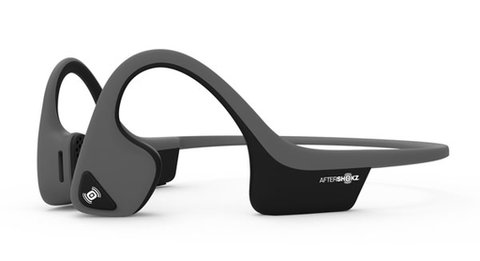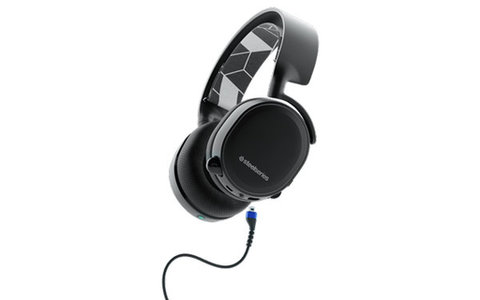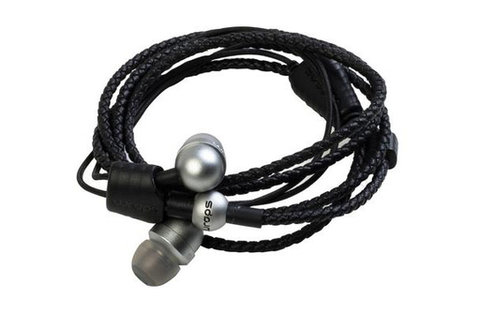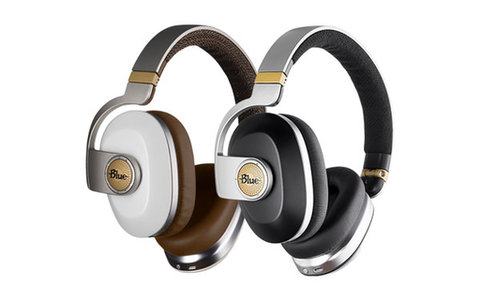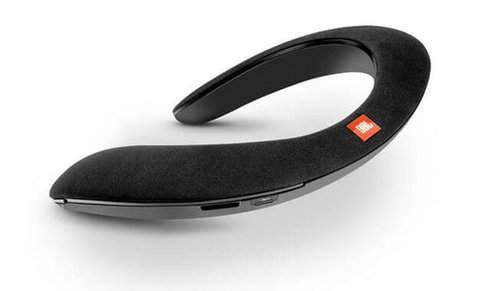Reviews
Sound of the Future
Reviewed: Seven of the Most Innovative Headphones Available Today
AfterShokz Trekz Air
bone conduction headphones
£149.95
AfterShokz has bucked the recent trend for noise isolating and cancelling headphones with its open-ear Trekz Air wireless headphones. Lightweight and wireless, the sports headphones use bone conduction to enable the wearer to remain aware of their surroundings, however this comes at the detriment of sound quality and volume.
Marketed by the company as ‘inspired by the demands of elite and aspiring athletes motivated by their music and their world’, the wireless headphones hook over the ears and wrap around the back of the neck. On long runs and cycles they proved comfortable and stayed in place, and other than mild pressure against the top of the jawbone (to enable to the bone conduction to work) their light weight (the Trekz Air weigh in at 30g) is a big selling point for longer workouts.
The key design feature of the Trekz Air is that they are actually speakers, rather than earphones. And, if being able to hear what’s going on around you isn’t enough, there is a large and easy-to-use pause/mute button on the left hand side of the headphones, which also acts as a skip button if double-pressed. Thanks to the use of titanium in their design, the Trekz Air are strong but very flexible, which means they can be chucked in a gym kit bag or pocket without worrying about damaging the headphones or tangling any wires.
Setting up the headphones was easy, with a female voice confirming that Bluetooth pairing with a phone was successful. The controls are relatively simple to use too – on the right hand side are the power and volume buttons, while the pause/mute and skip button is on the left. The Trekz Air also enable hands-free calls – each speaker is equipped with noise cancelling microphones to reduce ambient noise during calls.
While design and ease of use is excellent, where the Trekz Air fall down is in sound quality, volume control and battery life. In a quiet environment, people close to you are definitely able to listen to your music, while conversely, in a noisy or busy gym, the sound isn’t very clear. Turned up to full volume, you also start to feel the vibrations on your jawbone, which is an odd and mildly uncomfortable sensation for longer periods of time. The battery only lasts up to six hours (the lightweight design is to blame here), so don’t expect them to last for longer than about 2-3 workouts – and for the price (£149.95 on Amazon) I’d expect slightly better.
Overall, the AfterShokz Trekz Air are great for running and cycling as they offer the bonus of situational awareness and are light and very comfortable to use, however I wouldn’t recommend them for use in a busy gym or noisy environment, and for the price tag I would expect better battery performance.
Samsung Gear IconX
cord-free fitness earbuds
£199
Samsung’s second-generation wireless earbuds convince with comfortable fit, great audio quality and a range of nifty features for fitness enthusiasts, but fall short on battery performance and iOS compatibility.
Completely wireless earphones are the holy grail for the fitness accessory market and Samsung’s Gear IconX hit the spot with their snug and comfortable fit and flawless Bluetooth connectivity. We put them through the test for everything from HIIT to weight-lifting and long-distance running and they stayed perfectly in place, offering complete freedom of movement and great sound.
Promising 5 hours of Bluetooth streaming and 4GB memory for MP3 storage, the Gear Icon X seem like the perfect workout companion – and for shorter sessions they certainly deliver. But if you’re streaming for more than two hours at a time or don’t recharge them after each workout, the battery life becomes a serious let-down. When the battery drops to around 80% the volume starts to decrease rapidly, and what’s worse it does so unevenly across the two buds, meaning you’ll end up with lower volume or no sound at all in one ear.
As the Gear Icon X are entirely button-free, navigation works by tapping or swiping on a small sensor surface on the outside of the buds. This is quite nifty once you’ve remembered the tap and swipe combinations for all commands, but also means that accidentally brushing across the sensor surface can skip tracks or turn off the music mid-workout, so a lock function would be useful.
The buds have a built-in function to detect walking and running, which logs time, distance and calories burned, as well as a running coach feature. However, to use the tracking you need to sync them with Samsung’s S Health app, which is only available on Android and Google Play, meaning iPhone users will miss out on this feature.
Similarly, the Samsung Gear app, which is needed to adjust the earbuds’ settings or load them with music, is not available for Apple devices, leaving iPhone users limited to the slow and clumsy desktop software for managing their buds.
Overall, the Gear IconX are great for fit, comfort and sound, but probably not the best choice for iPhone users. And for the hefty price tag I’d expect better battery performance.
Steelseries Arctis 3
Wireless Gaming Headset
£134.99
I’ve never been particularly sold on wireless headphones, having never felt particularly bothered by being tethered by a cable. Admittedly this meant I’d never really bothered trying them, but the persistent thought was why would I pay more to remove a cable that doesn’t bother me and have to worry about battery life? The Steelseries Arctic 3 may well have changed my mind.
Staying comfortable for hours, partially due to their ski strap adjustable headband, the headphones also seem to have a pretty long battery life. Charging them to full out of the box took about two to two and a half hours but since then I’ve used them on and off for a few weeks, almost entirely wirelessly, and haven’t yet had to charge them again. They haven’t been used in particularly long bursts, probably topping out at about an hour in one sitting, but they’re holding charge longer than expected.
The design in general is near excellent: easy pause and skip track control, a high quality mic that extends and retracts nice and smoothly, and an overall pretty easily understandable usability. Easily paired via Bluetooth, though it should be noted that while a minor problem there is a slightly unclear variation of flashes indicating connectivity, the headset also benefits in wired mode from a substantial cable length to ensure you’ve got plenty of manoeuvrability around your pc.
Gaming is what the Arctis 3 is really designed for, with the aforementioned high quality mic providing top notch audio and easy connectivity to the Nintendo Switch chat app and Discord. Within the Steelseries engine, an app that acts as a sort of hub for managing settings and extensions for your headphones, there’s even a specific Discord customisation.
Aside from these integrations, the engine in general allows for some pretty nice tinkering on the audio settings of your headset. There’s a range of profile settings available (Cinematic etc.) and you can also make your own custom profile depending on how you like your audio mixed.
However, even with Steelseries engine installed and set up, and this is my only major gripe with the headset, I had to have my audio jacked up to max to get anything close to normal volume when I was using it plugged into my pc. It’s possible this is just a missing driver thing, but my natural assumption would be that when setting up the engine, a process that involves it recognising your specific headset, it would make sure said headset was optimised. Having to switch over to my regular headset, which I usually have at only one stage of volume above mute, during a Skype chat to actually be able to hear the other people on the call is less than ideal. Admittedly I had no problems with this when plugging into my laptop or Switch so who knows, maybe it’s just a desktop oddity.
That said, I had no such problems over Bluetooth and the audio I did get was of a really good quality. Perhaps predictably given its intention for voice chat, the vocals in any song particularly stood out with their clarity. I’m willing to chalk up the wired volume problem to a potential driver issue and if that is the case, this score can bump up to a full five.
Avanca D1
sports headset
£49.95
Avanca’s almost-wireless sports headset offers a flexible and secure fit, weather proof cover and good connectivity, but the sound quality could be better.
Not fully wireless as Avanca claims, the D1 headset’s in-ear buds are connected by a moulded cable that runs over the ears and sits snugly around the neck. The buds are small and light enough to not get in the way and stay firmly in place, with only minor slipping on long and very sweaty runs. An optional weather proof cover promises to protect them from the elements during outdoor use.
Bluetooth set-up is quick and hassle free, and the controls for music and call functions are pretty straight-forward through the buttons on both buds. The headset connects to smartphones, smart watches, MP3 players and other Bluetooth devices and the connectivity for music streaming is steady. NFC is also supported – although I didn’t get a chance to test that.
Avanca promises up to 6 hours of battery life, which seems about right from what I found while testing them. It’s certainly enough to leave the headset in you gym bag for the week without having to worry about recharging.
So far it all seems to add up to a great sports headset, but when it comes to sound quality the D1 could really do better. The sound is quite tinny with little depth and bass – a combination which can become irritating when you crank up the volume.
For the £50 price tag I’d expect better sound quality, and despite the good fit and functionality it’s this flaw that makes the Avanca D1 a decent headset, but not quite a great one.
Wraps CORE in-ear wristband headphones
£49.99
Upon first glance, the Wraps CORE edition in-ear headphones may look like any other pair on the market, but unlike traditional headphones, Wraps have a unique design element that merges fashion with function. They are specially crafted to wrap around the wrist into a bracelet when not in use. When worn on the wrist, a unique slider system keeps the alloy heads, slider and jack plug all connected for a secure and convenient way to ensure that your headphones are quite literally to hand.
The CORE range is available in four digital device inspired colours: Rose gold, silver, grey and gold, which are matched with a black faux leather bracelet cord. With the premium CORE range, you get upgraded titanium speakers, noise isolating foam tips, a stylish leather-look cord and a universal one-button microphone which allows you to pause and play music and answer calls on-the-go.
For the £49.99 price tag, you would expect a better audio quality. Even with the upgraded speakers, the overall sound quality isn’t as good as you might expect from similarly priced options on the market, but the Wraps do provide a good level of clarity across a variety of music genres.
Also, while the braided cord may look stylish, it creates a loud noise when it rubs against your clothes, which can interfere with your audio experience.
Overall, while the bracelet design gives the Wraps a novel appeal that similar offerings lack, if you are looking for clear and crisp sound quality then you may want to opt for another pair of headphones. However, if you care more about style and convenience, then the upgraded Wraps are an intriguing idea.
Blue Satellite wireless noise-cancelling headphones
£385
Last year, I was at an event and I got talking to a guy who worked on virtual reality for Sony Playstation (PSVR). I asked him why PSVR was doing so well in comparison to Oculus’ VR offerings, and he told me it was because Sony, unlike Oculus, knows what it’s doing when it comes to pricing consumer electronics.
If I could give Blue any advice, it would be to learn from companies like Sony because Blue’s Satellite headphones aren’t just expensive, they’re almost offensively priced, and that’s a shame because they’re good headphones.
Sound, comfort, design, performance are all excellent. Sure they’re a little bulkier than they really need to be, but they look and sound great.
In fact, everything I’ve listened to using the headphones has come through crystal clear, and for audiophiles, the Satellites have a built-in amplifier. If I’m honest I couldn’t tell the difference when this amp was activated, music sounded slightly sharper, but the difference was hard to notice.
Alongside the amp, the headphones also come complete with what Blue describes as “groundbreaking patented active noise-cancelling technology”. In all honesty, I found this worked about as well as the amp, a slight improvement but nothing to boast about.
These two gripes aside and there are no complaints from me about the Satellites usability. I had them on every day for about a month on my hour-long commute, and I seldom had to touch them because of discomfort, and I never had to mess around with them or my phone because I’d lost signal.
The built-in amp and noise-cancelling tech both work, just not as well as hoped. However, had Blue never installed a built in amp, I would have been more than happy with the sound quality the headphones deliver as standard.
My biggest gripe is the price, when both Bose and Sony have cheaper alternatives on the market, selling a more expensive option just seems silly.
JBL Soundgear BTA
Wearable Wireless sound
£199.99
Sitting somewhere between headphones and speakers, the JBL Soundgear is one of those rare products that’s genuinely unique in its field. Designed to form a bubble of sound around the wearer, it is perhaps the only device to ever be recommended for use with both virtual reality and housework, although presumably not at the same time.
Entirely wireless, it can connect directly to devices via Bluetooth, or via a small transmitter that comes with the Soundgear for devices that don’t have Bluetooth on their own. As a result, you can move around doing light to moderate activity while accompanied by even, high quality music of your choice, without missing out on the other sounds going on around you.
It’s an unusual idea, but one that JBL delivers on very well. The Soundgear does have lovely sound quality and, with such an even tone, it’s easy to forget you’re actually wearing it. As a result, you can walk around comfortably without having to leave the source of your music or untether yourself from headphones, and that’s a pretty fabulous experience.
Built-in volume buttons also allow you to adjust as needed, which is particularly good when listening to playlists, although there is no skip button on the device, which would have been appreciated.
I was very impressed by how loud I could get it before others in the same room could hear it. Playing it slightly too loud in the generally silent Factor office meant my colleagues sitting a few metres away could just about make out my terrible music choices, but mostly were unaware of the nonsense I was listening to. People sitting next to you would certainly be able to hear your music, so this isn’t a great option for the morning commute, but it would be ideal for listening to music or gaming in communal spaces where you don’t want to distract others.
The design of the Soundgear, however, is one of its biggest appeals, with a subtle curve that allows it to sit perfectly across your neck. This, I suspect, is one of the key reasons why, despite being pretty heavy, it is comfortable to wear for such long periods. In an ideal world it would be a little lighter, but I suspect that with current technological capabilities the sound, price or battery life would have been compromised.
On the subject of battery life, the JBL does not match up to some wireless headphones on account of its speaker-like design, but is still good, giving you up to 6 hours after a 2-hour charge. In reality I found it didn’t always make it this long, but still gave me a good chunk of listening time to enjoy.
Of course, the biggest issue with the Soundgear is the price. At just shy of £200, this is undoubtedly a luxury more than a necessity. But for those with cash to burn who find the idea of being encased in a musical bubble appealing, it might well be worth the price.
